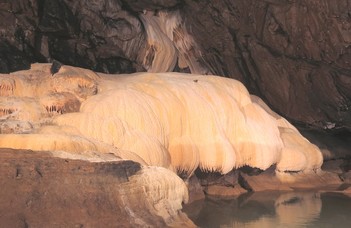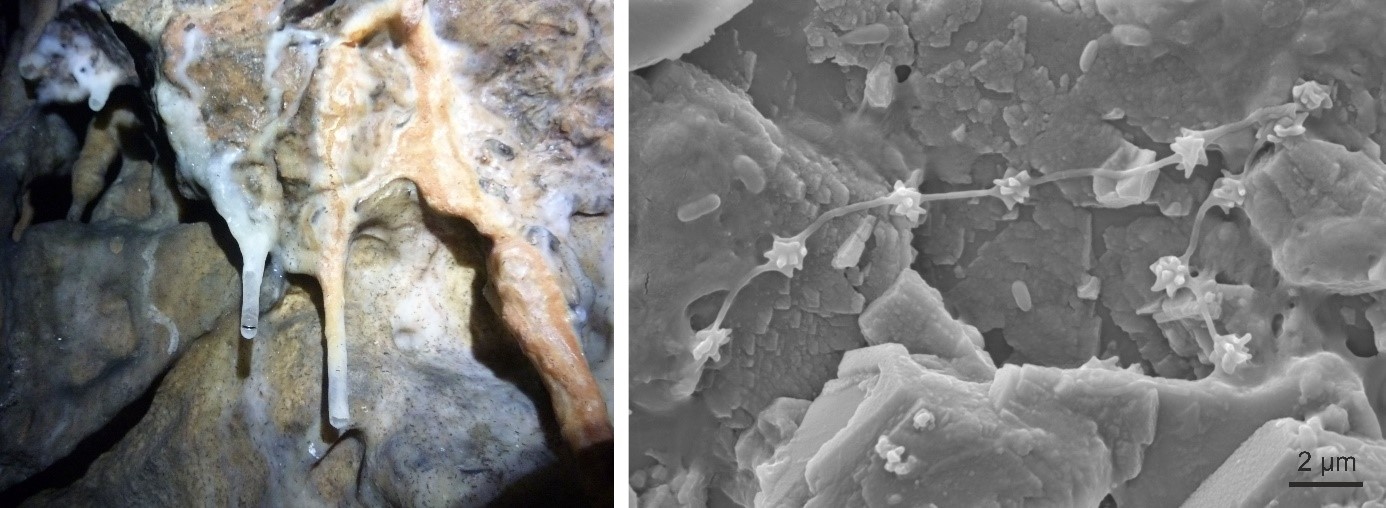Bacteria from Baradla Cave help the climate change researches

Carbonates are ubiquitous minerals and occur in various forms in our environment. In addition to being the dominant constituents of sedimentary rocks (limestone, dolomite), the shells of unicellular animals, mollusks, as well as numerous living creatures commonly consist of carbonates. The construction industry uses it in large quantities as a cement raw material and as a decorative stone, and it also occurs as limescale on our household devices. According to literature data, crystalline carbonate formation starts with an amorphous carbonate that consists of units with short-range repetitions. This amorphous material has a key role in biomineralization and carbonate polymorph (e.g., calcite and aragonite) selection. However, the study of the amorphous carbonate is quite challenging as it rapidly transforms to crystalline materials in room temperature.
According to the paper published by scientists from the Department of Microbiology and Department of Physical and Applied Geology (ELTE), Institute of Materials and Environmental Chemistry (RCNS), Institute for Geological and Geochemical Research (RCAES) and the Department of Earth and Environmental Sciences (UP), bacteria cultivated from Baradla Cave are capable of stabilizing amorphous carbonate in room temperature, and thus provide possibility for the multispectral analysis of this peculiar carbonate form and the better understanding of carbonate formation.
The scientists were motivated by their previous article and the NKFI FK123871 OTKA project that targeted the study of the peculiar carbonate. In 2016 the amorphous material was identified from the Baradla Cave belonging to the UNESCO World Heritage (Fig. 1), but its origin was unknown. However, the scientists suspected that microbial activity has an important role in the firstly precipitating carbonates.
For detailed microbial investigation, the scientists placed media under the dripwater and sampled the surfaces of the dripstones as well as collected dripwater (Fig. 2). Some weeks later 0.1- 0.2 mm-sized white calcite grains appeared on the surfaces of the colonies (Fig. 3). Scanning electron microscope images showed that calcite and bacterial cells are covered by 50 – 100 nm-sized globules (Fig. 4), which are commonly associated with amorphous calcium carbonate (ACC) in literature. For the clear identification, scientists applied detailed structural analysis, in particular, they used the Talos Thermo Scientific transmission electron microscope acquired in 2018 and housed in the University of Pannonia. They determined that bacteria in fact precipitate amorphous carbonate, which is protected by an extracellular polymer for several months. The authors also identified a large amount of fatty acids in this protective layer and concluded that amorphous carbonate presumably occurs inside a structure consisting of fatty acids. However, as the bacterial cells lyse, the covering protective layer disintegrates and ACC grains crystallize to calcite.
According to the study, amorphous carbonate may be common in temperate caves and its occurrence is directly linked to bacterial activity. This material presumably influences the geochemical signal recorded in cave sediments and thus the conclusions of past environmental and climate changes. However, the bacteria-stabilized amorphous carbonate can provide an excellent opportunity for characterizing this peculiar material.

Fig. 1. Carbonate speleothems from Baradla Cave. Photos were taken by Szabolcs Leél-Őssy.

Fig. 2. Soda straws developed in Baradla Cave and bacterial cells inhabiting on their surfaces (scanning electron microscope image). Photos were taken by Judit Makk.

Fig. 3. Stereo microscope images of 2 weeks-old and 22 weeks-old colonies of strain BaTD-248. The amount of calcium carbonate precipitates (white arrows) increases with time within the colonies. Black arrows point to the edges of the colonies. Photos were taken by Nóra Enyedi.

Fig. 4: Scanning electron microsope images taken from half year-old desiccated colonies of strains BaTD-248 (left figure) and BaSD-223 (right figure). Selected calcite grains and bacterial endospores of strain BaSD-223 are covered by 50-100 nm-sized Ca-carbonate spheres (black arrows). The sign of bacterial activity appears as holes (white arrows) on the surface of the crystals. Images were taken by Péter Németh.
The research was supported by the NKFI FK123871, the NANOMIN (KEP-8/2018) and the GINOP-2.3.3-15-2016-0009 projects. The authors acknowledge financial support from ÚNKP-19-3-I-ELTE-547, ÚNKP-19-3-I-PE-47, ÚNKP-19-4-PE-4 New National Excellence Program of the Ministry for Innovation and Technology and János Bolyai Research Scholarship of the Hungarian Academy of Sciences.
Enyedi N.T., Makk J., Kótai L., Berényi B., Klébert Sz., Sebestyén Z., Molnár Zs., Borsodi A.K., Leél-Őssy Sz., Demény A., Németh P. Cave bacteria-induced amorphous calcium carbonate formation Scientific Reports, https://doi.org/10.1038/s41598-020-65667-w
